|
|
The Top 5 of 2004
The list of "Top 5" stories related to "Bible Places"
in 2004 reflects just how much attention "biblical archaeology" has
received in the mainstream press this year. Unfortunately, some of
that attention has been given to unworthy subjects, including what
received the most sensational coverage, the "Cave of John the Baptist."
Because of our interest and location in Israel, the following list is
biased towards stories related to Israel, rather than
other countries in the biblical world. If you have a suggestion
for another story that should have been included,
let us know.
#5: Cana Discovered?
The big religious story that aired ahead of Christmas
this year was the "discovery of Cana" where Jesus performed his first
miracle. The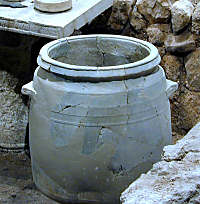 headline got everyone's attention, but unfortunately the media reports
we saw seem not to have analyzed the claims carefully. If you missed it, you can read the AP
story
here or
here or
here,
but don't believe everything you read. To start with, a big part
of the story is the discovery of a certain type of jar; the presence of
this jar in the excavations at Kefar Kenna is taken as evidence that
Jesus performed the miracle at this spot. To be sure, this stone
jar was used by Jewish people in the 1st century because of ritual purity
laws, and it is of the same type mentioned in John's account (2:6). But
stone jars of this type are common to this period and have been found at
numerous sites in Israel (especially in Jerusalem; see photo at right).
headline got everyone's attention, but unfortunately the media reports
we saw seem not to have analyzed the claims carefully. If you missed it, you can read the AP
story
here or
here or
here,
but don't believe everything you read. To start with, a big part
of the story is the discovery of a certain type of jar; the presence of
this jar in the excavations at Kefar Kenna is taken as evidence that
Jesus performed the miracle at this spot. To be sure, this stone
jar was used by Jewish people in the 1st century because of ritual purity
laws, and it is of the same type mentioned in John's account (2:6). But
stone jars of this type are common to this period and have been found at
numerous sites in Israel (especially in Jerusalem; see photo at right).
The story quotes the archaeologist as saying, "All
indications from the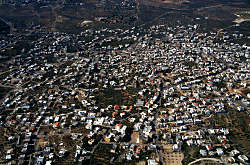 archaeological excavations suggest that the site of the wedding was
(modern-day) Cana, the site that we have been investigating."
These indications are 1) the stone jars mentioned above, 2) the
discovery of a Jewish ritual bath (mikveh), and 3) locally made pottery
suggesting the town was a poor village. But ritual baths and local pottery
are common in
Jewish villages in Galilee in the first century A.D. None of these
factors remotely suggests that the site should be identified as biblical Cana. What does argue in favor of this identification is not new
(and not mentioned):
the tradition, and the name Kefar Kenna which allegedly preserves the
name of Cana.
archaeological excavations suggest that the site of the wedding was
(modern-day) Cana, the site that we have been investigating."
These indications are 1) the stone jars mentioned above, 2) the
discovery of a Jewish ritual bath (mikveh), and 3) locally made pottery
suggesting the town was a poor village. But ritual baths and local pottery
are common in
Jewish villages in Galilee in the first century A.D. None of these
factors remotely suggests that the site should be identified as biblical Cana. What does argue in favor of this identification is not new
(and not mentioned):
the tradition, and the name Kefar Kenna which allegedly preserves the
name of Cana.
This evidence is weak, however, as
Carl Laney has
shown.
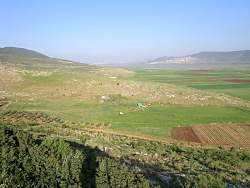 The tradition identifying Kefar Kenna as biblical Cana essentially
begins in the 17th century(!), and the name Kenna may or may not be related
to Cana.
Instead, the site of Khirbet Kana is superior in respect to all of the
evidence - name preservation, geographical location, Josephus, and
ancient pilgrim accounts (see SWP map here). Nearly all modern scholars agree with
this identification, including Robinson, Albright, Baly, and Aharoni.
The findings of recent excavations by the
University of Puget
Sound support this identification (cf.
related story).
Kefar Kenna needs a lot more to be biblical Cana than a few stone jars.
For a full discussion, see "The
Identification of Cana of Galilee," by J. Carl Laney - now online in
pdf format.
The tradition identifying Kefar Kenna as biblical Cana essentially
begins in the 17th century(!), and the name Kenna may or may not be related
to Cana.
Instead, the site of Khirbet Kana is superior in respect to all of the
evidence - name preservation, geographical location, Josephus, and
ancient pilgrim accounts (see SWP map here). Nearly all modern scholars agree with
this identification, including Robinson, Albright, Baly, and Aharoni.
The findings of recent excavations by the
University of Puget
Sound support this identification (cf.
related story).
Kefar Kenna needs a lot more to be biblical Cana than a few stone jars.
For a full discussion, see "The
Identification of Cana of Galilee," by J. Carl Laney - now online in
pdf format.
#4: Temple Mount "Garbage"
The Bible describes the area of the Temple as the
place where the Lord chose to "set his Name," and thus it's no surprise
that this area is so frequently in the news. Though archaeologists
are forbidden from supervising work on the Temple Mount, one should expect more
valuable information from on-going and future projects. This year
the bulges on the southeastern corner of the mount (near "A" in photo
below) continued to be repaired (Jpost;
here are some photos taken a few days ago of
both bulges, the
southern bulge area (and
close-up), and the
eastern bulge area (and
close-up of missing stones)).
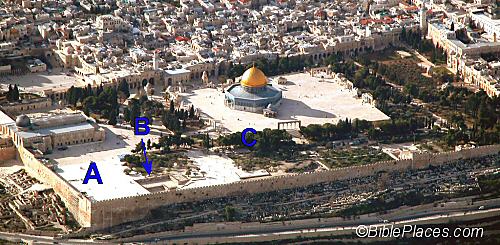
Material which was removed in construction of a mosque in
"Solomon's Stables" and dumped on the Temple Mount (marked "C") and in
the Kidron Valley may yet reveal valuable finds. A sifting operation
was recently begun by Israeli archaeologists to sort through dozens of
tons of earth. Haaretz published an article entitled "Remnants
of the Temple? Not in this garbage," but see
this page to see
objects discovered in the "garbage" (and
here for other related
photos). Volunteers are
wanted.
In addition, plans are now underway to remove
the large earthen embankment south of the Western Wall prayer area
(the arrow in this photo points to area to
be removed). This could reveal some interesting material next year.
#3: Cave of John the Baptist
This is the top non-story of the year, but it makes the list because
the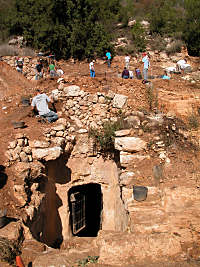 news coverage of this was so widespread and sensational.
Contrast this with story #1 below and see one reason why you can't trust
the amount of media coverage to determine what is important. This cave is
alleged to be the ritual center of followers of John the Baptist, but the
primary piece of evidence is a
stick figure drawing on the wall of an
ancient cistern. Why this is John and not any other known or
unknown personage is never made clear. The best thing going for
the identification is the location of the cave: 2.5 miles (4 km) from the traditional
birthplace of John the Baptist at
Ein Kerem.
For more, see our
brief
critique of the cave; to our knowledge, no scholars back the
excavators' identification of the cave. news coverage of this was so widespread and sensational.
Contrast this with story #1 below and see one reason why you can't trust
the amount of media coverage to determine what is important. This cave is
alleged to be the ritual center of followers of John the Baptist, but the
primary piece of evidence is a
stick figure drawing on the wall of an
ancient cistern. Why this is John and not any other known or
unknown personage is never made clear. The best thing going for
the identification is the location of the cave: 2.5 miles (4 km) from the traditional
birthplace of John the Baptist at
Ein Kerem.
For more, see our
brief
critique of the cave; to our knowledge, no scholars back the
excavators' identification of the cave.
#2: New Verses Found on Old Silver Amulets
Sometimes old finds can yield new information, as was
attested by newly discovered references to Scripture on silver amulets
from Ketef Hinnom. These amulets are renowned because they are the oldest known copies of Scripture, preserving the priestly blessing
from Numbers 6:24-26 (brief description and photo
here). Archaeologist Gabriel Barkay dated them to about 600
B.C., before the destruction of the First Temple.
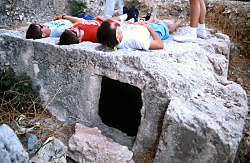 |
|
Ketef Hinnom repository: Location
of discovery of amulets |
Recently, innovative
photographing technologies have allowed scholars to see parts of the
inscription previously unknown. The new reading of the first
amulet includes, "YHW...the grea[t...who keeps] the covenant and [G]raciousness
towards those who love [him] and those who keep [his commandments]."
This parallels Deut 7:9, Neh 1:5, and Dan 9:4. The second amulet
mentions, "Yahweh, the warrior (or helper) and the rebuker of [E]vil,"
which is reminiscent of Zech 3:2. The new readings were published
in an article in
BASOR 334 (May 2004), and an article about the technologies used was
printed in Near
Eastern Archaeology 66/4 (dated Dec 2003, but actually printed about
Nov 2004). The New York Times ran an article on it with
photos, which is now
preserved at this
site.
#1: The Pool of Siloam Revealed
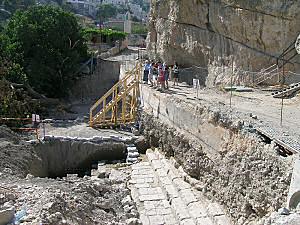 |
|
Excavations as of June |
This clearly is the story of the year, though you
wouldn't know it from the news coverage which has been almost
non-existent. There were two brief stories in June (JPost;
may require free registration),
and a Christmas rerun with a few new details (JPost
or
here).
In contrast with the "Cave of John the Baptist," this water installation is clearly
related to the New Testament. It's also visually impressive and
bound to be more so as excavations continue. Archaeologists Eli Shukrun
and Ronny Reich uncovered this in the summer and have made
significant progress in the last six months. As of a few days ago,
twenty steps
have been revealed and the bottom has not yet been reached.
Pottery indicates that this pool was in use in the 1st century.
The blind man washed the mud off of his eyes in this pool and received his sight
(see John 9).
A wild prediction: this will be the archaeological discovery of the
decade for biblical studies. At least there is no chance of it
being declared a forgery.
| |
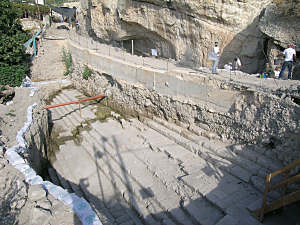 |
|
| |
Excavations as of November |
|
Other Stories of the Year
The Fakes: Discussion continued this year on the authenticity of the James Ossuary (Shanks
interview, recent
CBS story) and Jehoash Inscription (Haaretz,
bibliography).
The Israel Museum announced a few days ago that it has determined that the
inscription on the famous, ivory pomegranate from Solomon's Temple was
forged (ABCNews).
The pomegranate itself dates to the Late Bronze Age, but investigators
say that the inscription was made in modern times. This
afternoon, Israeli police issued an indictment against the owner of the James
Ossuary, alleging that he and 3 antiquities dealers ran a forgery ring
that created numerous "biblical artifacts" by adding inscriptions to
genuine artifacts, including the Jehoash Inscription, ivory pomegrate,
seal of Manasseh, Second Temple period menorah, and the James Ossuary
(adding the phrase, "brother of Jesus"). The full story is run by the
AP and
Haaretz.
A few photos of the news conference are displayed on
Yahoo. Back in the sights of some: the Dan Inscription (see
ANE thread).
Qumran Theory #13: Yet another new theory has been offered on the function of the
Qumran site. Excavators Magen and Peleg believe that Qumran was a
pottery-producing factory, and not a quiet community inhabited by Essenes. You can read the story at
Jerusalem Post or on
The Bible and Interpretation website. One brief response can be
found on the
ANE list. For a list of 12 other theories on Qumran's
function, see the end of this
JPost article.
A Modern-Day Plague: Swarms of locusts swept through northern
Africa and into Israel in November. As in biblical times, the
locusts threatened to "cover the face of the ground
so that it cannot be seen" (Ex 10:5), but Israel's agriculture was
largely spared by cold weather and spraying (Arutz-7
story).
Next Year's News Story: Excavations of the Western Wall, south of the
prayer area, should reveal the full width of "Barclay's
Gate" (see
Arutz-7,
Haaretz, and photo mentioned above).
Stunning Jerusalem View
Finally, take a look at this stunning aerial photograph of
Jerusalem (1 MB
size) from on another website.
Unfortunately it's in a flash file, so you can't edit or manipulate it
easily, or put it in a PowerPoint file. But you can enjoy it, and
by it remember the exhortation to "pray for the peace of Jerusalem."
Use These Photos!
The images included in this newsletter are original
BiblePlaces.com photographs and are linked to high-resolution versions.
They may be used freely for personal and
educational purposes. Commercial use requires separate permission. For more high-quality, high-resolution
photographs of biblical sites, purchase the
Pictorial Library of
Bible Lands, now available through Kregel Publications.
Subscribe to the BiblePlaces Newsletter!
A monthly
newsletter on subjects related to biblical sites and archaeology. New and
discounted photo CDs will be announced here, and free high-resolution photos
made available for free each month! Have a problem subscribing? See
this page.
|

